Hallucination Engine Revisited: Psycho-Dynamic Obsolescence of General Motors
I am a child of General Motors — an ex-auto junkie United
Auto Worker raised in dealerships and auto plants. I am peak oil,
the auto-sprawl,
carbon dioxide, speed and redundant mobilty.
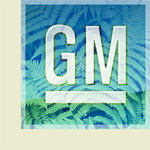 This
is the intervention. This
is the intervention.
Today,
I shop on the showroom floor of illusions. Amidst Ford‘s
chest-thumping “we will survive without a bailout” proclamation,
Chevy’s greenwashed prediction that their extended-range
electric Volt (another candidate to overload the grid) will cure
post-Chapter
11 pain, and taxpayers’ frustrated cries from adjusting
to the dubious understanding that they have suddenly become stockholders
with no voting rights in the sputtering American auto industry,
my
Zeitgeist – “What’s good for General Motors
is good for America,” went bankrupt. Hummer rolled over;
Saturn eclipsed; Pontiac and Oldsmobile phased out. While the
post-bankruptcy
GM announces it will focus on "developing vehicles that can excite
buyers," all I feel is the wisdom of dead junkies, that but for
the grace of God…, and the dynamic obsolescence of hyper-mobility.
—
I
was a kid at a red light between the bucket seats of a 1958
hot-off-the-showroom-floor, two-tone Corvette convertible, top
down under an surreal March morning
sky, a Chevrolet jingle on the radio with a chorus singing "It's
all new all over again." When the light turned green,
the melody accelerated through my skin and evanesced into
the hills
above Sunset
Boulevard. I was hubcap-eyed hypnotized.
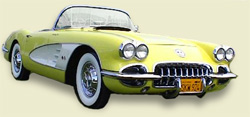 At
the wheel, wearing his favorite Don Loper shirt, Dad — a
parts department employee at Martin Pollard Chevrolet — smiled
sweet and satisfied like Jack Lemmon at 29. Next to him, Mom
smiled back in Shimmering Rose lipstick and butterfly dark glasses,
her
Vera scarf straight in the wind. Cruising west on the Sunset
Strip, we
were enshrined in the 'Vette — a Panama Yellow and Snowcrest
White barking GM spider dripping chrome. At
the wheel, wearing his favorite Don Loper shirt, Dad — a
parts department employee at Martin Pollard Chevrolet — smiled
sweet and satisfied like Jack Lemmon at 29. Next to him, Mom
smiled back in Shimmering Rose lipstick and butterfly dark glasses,
her
Vera scarf straight in the wind. Cruising west on the Sunset
Strip, we
were enshrined in the 'Vette — a Panama Yellow and Snowcrest
White barking GM spider dripping chrome.
My
eyes locked on the cloud-and-rooftop horizon above the dashboard.
Sparkplug bolts
of electricity hard-wired my brain. After a
fuel-injected hit of 20th-century freedom and mobility, I
was never the same
all over again.
"Let's
make this thing work," said Dad stepping on the gas.
The
engine om submerged me in a V-8 adrenaline bath. Lost in a 290-horsepowered
paradise-to-the-bone, I was 8-years
old and
burning-down-the-house
addicted to cars.
Before GM, we were clean. A few city blocks supplied all
the life we needed. We walked to work, to school, to shop
for
groceries. The church. The dry cleaners. The drugstore.
The bank. Our close
friends.
Get in a car to visit them? Never. Cars were meant for
a trip or a special occasion — not for a mundane
commute or errand. Let me explain in market terms for
investors in the new GM. Back in the
day, stocks were based on earnings, not derivatives; executive
salaries had something to do with portfolio performance;
you had to have verifiable
income to qualify for a loan; people had some idea of
to whom they owed money and sense of where that money
might come from. Get it?
But
we became addicts. We dressed for cars, schedule for
cars, wished for cars, cursed for cars and lusted for
cars. Our
leisure time,
speech, manners (or lack thereof), where we did business
and pleasure was
auto-dependent. We loved and hated cars, gave them names,
sang about them, insured their bodies, rubbed them until
they shined.
Deluded
into thinking that the outward rush of motorcar markets
could expand infinitely, we came to think of our planet
in the same
way — an
inflating globe growing without limits.
At
first it was 10 miles…then 50…100…200 miles
a day. Soon we couldn’t even eat without a car — all
of our behavior deformed in a Möbius strip cloverleaf
head-on crash. And now, GM is back from DOA. If that’s
a good sign, fuck me.
—
On
my way to work this morning, out-of-control Japanese taillights
flare and spin by. I've almost been
hit by a rice rocket trying
to avoid a squirrel. My Camaro is okay, but I'm
a wreck. I take a deep
breath.
"Try
to relax," I say. "Blend into traffic. Sink into your
leather seat. Get lost in the drone of the engine.
Flatten the wayward squirrel."
But
when I arrive at my office, I'm shaking — my
malignant inclination driving me downhill, shifting me between loving cars
and desperately
needing cars. Jesus Christ in a GTO, I need help.
It's time to call a doctor.
If
anyone can make me feel good about my automotive Jones, its Dr.
Kenneth Green, the ex-Director
of Environmental Studies at the Reason
Public Policy Institute, now-Resident Scholar
at the American
Enterprise Institute. He’s an old school
invisible-hand-of-the-marketplace libertarian.
Surely, he can talk me back up.
"There's
no validity to the argument that we are somehow addicted to cars," Green
says. "When someone approaches
me from your viewpoint, I just say two words:
'Conestoga wagon.' The truth is,
we've wanted greater mobility since the covered
wagon."
 Cool.
I keep quiet and listen. Economics is the driving force behind
the preponderance
of
cars,
according
to Green. We are,
essentially,
going places either to get money or spend
it. A wagon. A bicycle. A horse. An Acura. To a
good American
with
his
head on straight,
they're all simply economic conveyances. I
sense that this might be useful
information in my new role as a multi-tasking
taxpayer / stockholder in the new GM. Cool.
I keep quiet and listen. Economics is the driving force behind
the preponderance
of
cars,
according
to Green. We are,
essentially,
going places either to get money or spend
it. A wagon. A bicycle. A horse. An Acura. To a
good American
with
his
head on straight,
they're all simply economic conveyances. I
sense that this might be useful
information in my new role as a multi-tasking
taxpayer / stockholder in the new GM.
Outside
my second-floor window, a
Harley Davidson rumbles past, its antisocial posture splitting
the lanes
of the stagnant
citizenry. I
reel in a learned
neuro-synaptic response. A dopamine surge
brings me to my senses. What a
load of crap. A car is so much more than
a vehicle. It’s part of our
identity. A 57 Chevy is not a conestoga
wagon. It’s an obsession.
"We
have a demand for mobility that is almost insatiable," Green
informs me. "There's no limit to
how far people will want to spread out."
I'm
listening, but an engine starts humming
in my head. The room undulates. The
ceiling peels
back,
and a dark
universe emerges
above me. I rise
into it, enveloped in a future where
only one person inhabits each planet: A deep-space
version
of an
upscale gated
community — Cota
de Caza resized for libertarian futurist
philosophers strung out on mobilty. Powered
by economics and an insatiable primal
urge to spread
out, Dr. Green rockets by me punching
a Turbo 400 Buick Grand National into
the endgame of the Big Bang.
An
unanticipated coherent question pops
out of my mouth. "Shouldn't
we be focusing on the sustainability of
higher-density cities?" I
look behind me to see where the voice
came from.
"Most
people don't want to live in cities anymore," Green says. "Cities
create faster social disharmonies.
Riots spread faster. Pollution is in a higher concentration."
I
look out my office window. There's a gas station (CARS), a backed-up
metered freeway
onramp (MORE
CARS), an overpass
(EVEN
MORE CARS),
and beyond that tract homes in every
direction
(CARS TO THE EXTREME). I see no
human face.
"I
don't believe we're addicted to the car," he says.
Green
and I are clearly wasted.
Below
me — like a three-grain shot — a
1967 Shelby Mustang GT 350 in mint condition makes a turn out
of the parking lot. On
its rear passenger-side window is a sign that reads "FOR
SALE."
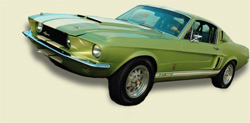 As
if in the expanded seconds of a car crash, my mind races between
my loyalties to the old order, my responsibility
to
taxpayer interests
in GM’s recovery, and an addict’s rationalization
that this may be the best of all highs – snorting the
ashes of Ford — the enemy and one of the founding fathers
of the American industry. As
if in the expanded seconds of a car crash, my mind races between
my loyalties to the old order, my responsibility
to
taxpayer interests
in GM’s recovery, and an addict’s rationalization
that this may be the best of all highs – snorting the
ashes of Ford — the enemy and one of the founding fathers
of the American industry.
Inside
my head a neon sign flashes, "YOU'VE
GOT TO HAVE THAT MUSTANG."
I
drop the phone, run downstairs, and jump into my baby. With a
sharp left, I'm in pursuit,
zipping by Old Town Irvine
and
its blacksmith-shop
theme restaurant. Strip-mall history offers the locals
a romantic image at the area’s history. They eat fries
and burgers under horseshoes, next to a blacksmith's forge,
basking in suspended disbelief
about the dangers of cholesterol as well as their denial
that transportation in the days when a horse was an urban
necessity smelled like shit.
Imagine
a horse-drawn metropolis on a rainy day, the street bubbling with
the stanky gumbo of ass
goblins; on a summer
day, the unscooped,
infected fecal ooze dehydrating and crumbling into a
fine dust rising burnished into the air, coating everything.
Within that
environment,
the car became our junkie Jesus of locomotion — the
savior and tempter of our muddy urban souls.
Before
its advent, thousands of dead horses were carted from
our city streets each year — unless, as often
happened, municipal street sweepers struck, stayed
home or stayed drunk. In that case,
decomposing corpses — spinning with flies — dished
up tongue and anus feasts for ravens.
What
did the future look like in 1890? Statisticians predicted
that by 1940, people living in densely populated
cities
would be up to
their knees in horseshit.
Rolling
through the yellow light at Culver Drive, I follow a different
horse — the
Shelby Mustang. In its contoured body is the
narrative of a hot romance…a torpedo full of adventure
for a twisted new age that promised to deliver us
from air pollution, congestion and death. Yeah. Now I’m
feeling better.
The
Mustang rolls into a carwash. What the hell: There're bugs on
my windshield and parkway
sprinkler trails
on my hood. I
can get
a wash, meet the owner and score the Shelby all
at the same time. I pull up to the vacuums, leave my
key in
the car
and follow the
Mustang man to a spot under a patio where we watch
a dozen Latinos sweat and wipe the water off sparkling
hoods,
roofs, trunks,
fenders, doorjambs and windows. Thin, long-faced,
wearing
a tweed suit
and a small brimmed fedora, the mustang owner
has an unsettling resemblance
to William S. Burroughs from the dead risen.
"That's my Ford," he says before I get a chance to speak.
"How
long have you owned it?”
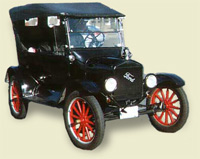 "It
was 1910 when the first Ford Model T came to Orange County." I
don't think
he hears my question. "All
black…squared-off…a
production line, one-size-fits-all piece
of history…the beginning
of the modern industrial age…the harbinger
of the Carnuba Sealer Wax shine," he
says "It
was 1910 when the first Ford Model T came to Orange County." I
don't think
he hears my question. "All
black…squared-off…a
production line, one-size-fits-all piece
of history…the beginning
of the modern industrial age…the harbinger
of the Carnuba Sealer Wax shine," he
says
I
flinch at the rush of precise details delivered in a measured
gravely voice. Was
this another
smug Ford
asshole
gloating
over the government-sponsored new GM’s lack of foresight?
"How
much do you want for your car?" I ask.
He
shivers.
"Henry
Ford cut the Model T's original price in two, because he wanted
everyone to own one… get them
hooked… even
farmers. Their wheelbase is exactly
as wide as a horse-drawn wagon's."
"So
what?" I say.
The
Mustang man pauses and looks me in the eye. "They
fit right into the ruts already worn into the roads. The suburb
and the car
were the perfect bump…a
synchronized transmission. During
the honeymoon,
the future looks limitless."
I
smile impatiently. "How
much do you want for your car?"
He
still doesn't answer.
"Bill?" says
someone whose shirt is embroidered with the name "Ramon."
The
man who looks like Burroughs gives Ramon his receipt with a
tip and gets into the
Mustang.
"Is your car for sale?" I ask.
"No," says
Bill, who's already beginning to drive away.
I
stare down at the ground, exasperated. Through a crack in the
pavement, glistening
with soapsuds and Armor-all, a spike
of green
stares back. It's
a sprout rooted in the best agricultural land in America — the
grade-A fields and orchards buried under the asphalt here
at the Irvine Auto Spa. This could be a remnant
of the walnuts, strawberries,
asparagus, oranges, corn, tomatoes, bell peppers, beans
and sugar beets worked by Ramon's ancestors. “Ready” he
says. I hand him seven
crumpled dollar bills and start my engine.
—
Things
aren't so limitless when I get on the
Santa Ana Freeway.
It's
jammed.
Every
new
northbound lane
all the way to the
Orange Crush — a
world-class entanglement
of freeway intersections
where the main
arteries between
San Diego
and Sacramento
wrap around one
another,
strangling the
flow of commuters
in
their quest for
a mythic ever-expanding
market — is
locked up with
heavy metal. No
matter
how much road
we have, we always
need more.
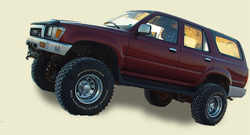 Ahead
of me, a
lifted Toyota
4Runner signaling
in a frenzy,
attempts
to change lanes.
A Lexus doesn't
want
to let
it in. Over
wild honking, the lips,
fingers and
faces of contorted
frustration
are contained behind
two windshields. Ahead
of me, a
lifted Toyota
4Runner signaling
in a frenzy,
attempts
to change lanes.
A Lexus doesn't
want
to let
it in. Over
wild honking, the lips,
fingers and
faces of contorted
frustration
are contained behind
two windshields.
I
punch the auto-scan on
my radio,
seeking traffic reports
and Sig-Alerts.
"And now the news," a voice chimes in. "It may
be easier to forgive bad drivers after you've gotten even
with them. This
may be the
case for some motorists, according to a recent survey of
traffic-school participants. The survey found that 31 percent
of the participants
have sought revenge by chasing another driver,
12 percent
threw an object at an offending car, and 5 percent rammed
the car. Three
percent had loaded guns in their cars; almost 2 percent
waved the
guns at another driver. And slightly less than 1 percent
pulled the
trigger."
Outside
my Camaro the
traffic
begins to
grow horns.
A
horde of
engines growl. I get
an
icy look
from a middle-class
teen confused
wanna-be
Scarface
with an achy-breaky
haircut — the
one in the
4Runner pickup.
Will he seek
revenge? Is
he armed?
The traffic
is at a complete
stop. He stares
at me as if
it's my fault.
He revs his
engine. I
look down,
trying to
avoid locking
eyes. Then
I see it — a
black, slick,
bubbly ooze
seeping through
the floorboards.
Before I can
react, I'm
up to my ankles
in a warm
pool of oil — crankcase
drips, tanker
spills, toxic
shit — rising
off the road.
"Get
me the fuck out of here," I yell at the dashboard as my
knees
start to simmer in the muck. "We've got 4 million miles
of highways
and streets in America. Hasn’t anyone heard of
peak oil?"
Traffic
creeps
forward.
CONSTRUCTION
AHEAD,
reads
a caution-yellow
sign.
The
oil
line in
my car
hits
my waist.
The
4Runner
teen
reaches
into
his
glove
carpartment.
I
think he's
got
a
gun.
I'm
about
to
leap out
the
door,
when
someone
toots
a
horn. It's
Bill
in
the Mustang.
I
motion
frantically
for
help
as
the oil
hits
my
chest.
Bill
just
points
to
the
yellow
signs
as
the oil
bubbles
up
my nose.
"Exterminate
all rational thought," he yells out of his window
as he inches by.
It
appears we
have.
The
next few
moments are
a stretch
of lost
highway that's
been blanked
out of
my memory.
—
When
I snap
to in
a Harbor
Boulevard gas
station minimart's
secured-for-my-safety restroom,
I'm
splashing water
on my
face and
rubbing my
clothes with
a cardboard
pine tree
shaped auto
air-freshener to
chase the
smell of
40-weight oil
from my
cognitive memory.
Outside, in
the afternoon
sun on
the street
corner, a
small crowd
gathers at
a bus
stop.
There
was a
time in
this country
when most
people got
to work
by foot
or by
public transportation.
In the
1930s, seven
billion commuter
trips each
year were
taken on
electric systems
like Southern
California's Red
Car line.
Where
did all
our streetcars
go?
Some
say that
the oil,
steel and
rubber industries — trying
to heighten our addiction to the automobile — bought
the lines and plowed them under (see Who Killed
Roger Rabbit?).
Others
say those
same industries
invested in
electric-powered
mass
transit only
to discover
the systems
were falling
short of
our transportation
needs (see Alice in
Wonderland).
For
whatever reasons,
General Motors,
Firestone Tires,
Standard Oil
and Mac
Machinery bought
out more
than 100
electric rail
lines in
45 American
cities over
13 years.
By 1950,
90 percent
of those
were destroyed,
including the
Pacific Electric
from Los
Angeles to
Santa Ana.
Now, in
its place,
we have
GM’s legacy — miles
of congested roads.
I
return the
restroom key
with its
miniature tire
fob to
the clerk
at the
counter and
browse the
magazine rack. Car and
Driver, AutoWeek,
Motor Trend,
Hot Rod,
Car Collector,
Car Craft. Next to Muscle Car
Review, I
spot a
pamphlet titled "Solutions
for an Auto-addicted Orange County."
"You can have a wonderful life without a car," it reads. "Get
in shape. Lose weight and increase cardiovascular fitness.
Save money. The average price of a car in Orange
County
is $21,544, and
it begins to depreciate in one day. Breathe easier. Cars
are the major source of air pollution."
 There's
a phone
number included:
(949) 452-1393.
Is this
a message
from the
god of
public transportation?
Have I
found my
cure for
pain? There's
a phone
number included:
(949) 452-1393.
Is this
a message
from the
god of
public transportation?
Have I
found my
cure for
pain?
I
rush outside
and fumble
for change
at the
pay phone
as the
bus-stop crowd
watches me
miss-dial, dial
again, miss-dial,
dial again.
A drunk
had plowed
down the
cellphone tower
on the
corner earlier
in the
day. The
signal-less Bluetooth
in my
left ear
clacks annoyingly
against the
heavy plastic
receiver cradled
between my
head and
shoulder. I
worry about
the ergonomics
of the
situation.
At
last, Jay
Laessi of Auto-Free Orange
County answers.
"I'm addicted to cars. What can I do?" I say.
"Try walking…first try walking," says Laessi
as if he handles 100 calls like mine every
day.
"Where?" I say. "I'm surrounded by cars."
"Orange County is one of the worst areas in the country
for that," he
says. "But if you can’t
walk, try taking a cab. They're $1.90 a mile.
If you can share one, it's even better. Or get
on
a bus."
Maybe
I should,
but I'm
apprehensive. How
will this
help taxpayers
get a
respectable return
on
our
government-mandated
investment
in
the American
auto industry?
"No,
thanks. No bus. Mass transit can't work in the suburbs," I
say, avoiding the real issue. "Southern
California is too much
of a sprawl for public transportation to work.
There's no central point of departure."
Laessi
disagrees.
“Smart people ride mass transit,” he says. “You
can get your work done, read a book or meet
someone. The first step is to
call 1 (800) 636-RIDE.
Can
you hold for a second?"
Before
I can
answer, I
hear another
number being
tone-dialed.
"Thanks for calling the Orange County Transportation Authority," a
new voice says. "Can I help you?" Laessi
has forwarded me through to bus-route information.
I freeze and babble something
into the phone. A minute later, the sweet voice
at the other end
of the line has informed me that OCTA can get me
home in 30 minutes.
30
minutes. Am
I kidding
myself? I’ll miss my drive-time junk:
my daily two-hour taillight tripsomania. I’m
in hurry. Let the man go through. The
smell of
fresh asphalt
wafting across
the street
from the
new right-turn-lane
replacing the
sidewalk
grips
me like
the dry-heaves.
“30 minutes,” the transit authority operator’s
kindness calms me. I can do this. I join the crowd at the
bus stop. They
eye me suspiciously at first and move imperceptibly away.
I know we’ll
grow to be friends eventually. If you're going to break
a habit, you have to get hooked on something
else.
—
Waiting,
watching cars,
a chill
hits my
body. I
do a
wet-dog shake
as an
engine hums
in my
ear.
It's
Bill. This
time he's
driving a
1959 seagull-wing
Chevrolet
convertible – a
throwback
to GM’s
golden days.
 "'Give to every people of every land better roads and more automobiles,
and we shall do away with most of the ill will that exists between human beings,'" he
says mockingly. "Some
jackass named Irwin Cobb wrote that in 1923. He
believed that World War I wouldn't
have happened if the
world had more cars." "'Give to every people of every land better roads and more automobiles,
and we shall do away with most of the ill will that exists between human beings,'" he
says mockingly. "Some
jackass named Irwin Cobb wrote that in 1923. He
believed that World War I wouldn't
have happened if the
world had more cars."
"Really?" I say. Silently I wonder. Was Cobb alive
to see WWII? What would he have thought of
this new millennium, where American
need for petroleum-based mobility secured an involvement
in seemingly endless foreign conflicts? Would
he have thought
the American auto
industry deserving of redemption in the form of a bailout?
Bill
looks me
up and
down. "You
need a lift somewhere?"
I
hesitate.
Shouldn't
I get
on the
bus? Don't
I want
to
kick
the habit?
"Are
you going to pass up a ride in Mr. Fin's first Chevrolet?" Bill
asks.
I
have no
idea what
that means,
but before
I know
it, I'm
heading south,
lost in
the huge
expanse of
the Chevy's
red-and-white interior.
"What happened to the Mustang?" I ask.
"Who
needs that shit?" Bill says. “I’m a Chevy man.
With fins like these, I can peel the skin off a bag lady. You
can thank Harley Earle for that. General Motors hired him in the
1930s
after seeing the custom cars he designed in Hollywood. At GM,
Earle reached down into the cars' guts and pulled out a personality.
They
called Earle "Mr. Chrome." One of his protégés — Bill
Mitchell — became
'Mr. Fin.' He cooked up this Chevy.
"GM had Earle making major design changes every year. Without this
year's model, you were yesterday's news. He called it 'dynamic obsolescence.'
General Motors called it huge profits."
We
wait at
the onramp
of the
5 Freeway
to cheers
of pedestrians.
The gull
wing generates
its own
audience. It's
Pop sculpture
on wheels.
"Earle's beautiful machines crept through traffic nightmares
in the 1930s," Bill says, sliding into the free-flowing
eastbound traffic. "Southern
California had streetcar-scale downtowns packed with
GM cruisemobiles. It was a mess."
Bill
reaches into
the glove
compartment
and
pulls out
a copy
of Los Angeles
Times dated
1938.
"Where the hell did you get that?" I say.
"Shut up and listen. The automobile, which was 'designed to be the
emancipator of man,' was 'defeating its own purpose,'" he reads
to me, slapping the paper for emphasis. "'Man
is being enslaved again by the servant he created.'
"So what did L.A. do? Lloyd Aldrich, a city engineer, pushed through
a plan for 600 miles of multilanes penetrating downtown. Right then and there,
the fast-lane lifestyle was born.
"When
the car and the city merged, urban energy was sucked away.
Cities became diluted…borderless.
A crisscross concrete grillwork defined Southern
California, scattering businesses and homes to
places ruled by the car.
Dynamic obsolescence described our way
of life.
Southern
California became
a microcosm
of suspended
disbelief, an
object lesson
in pushing
a flawed
plan forward
on the
specter of
aggressive market
expansion — manifest
destiny without
regard for
the
realities of resources.
Through
the Chevy's
huge windshield,
tract homes
and strip
malls float
by. We're
above the
flatland
of
Orange County
on the
elevated, quater-mile
long carpool
lane linking
the Interstate
5 to
State Route
55
southbound.
Bill continues.
"Cramped non-ethnic Californians were enchanted by the spectacle
of Motorama during the '50s and into the early '60s; it was GM's car-show vision
of tomorrow. At the Pan Pacific Auditorium in L.A.,
a scale-model of a future metropolis paraded cars through pollution-free air-tight
Corbussier vistas.
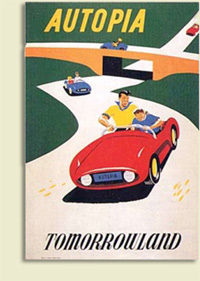 "That was the blueprint," he says like Rick Warren
in a self-possessed rant. "In
1955, the blueprint was made real with the opening
of Disneyland and the
Santa Ana Freeway. Some people thought Disneyland
would be a permanent
world's fair. I say Orange County is Motorama." "That was the blueprint," he says like Rick Warren
in a self-possessed rant. "In
1955, the blueprint was made real with the opening
of Disneyland and the
Santa Ana Freeway. Some people thought Disneyland
would be a permanent
world's fair. I say Orange County is Motorama."
We
cross five
lanes of
traffic in
less than
a half
mile to
glide onto
Interstate
405
south,
flashing
by the
blocks of
steel, glass
and concrete
that
is
South Coast Plaza. The
1959 Chevrolet
feels like
an E-ticket
ride.
"Even our goddam president started pushing the car," Bill says,
attempting an impression of Dwight David Eisenhower: "'Automobiles
mean progress for our
country, greater happiness and greater standards
of living.' That's what Ike said.
"Congress agreed and laid down the cash for the construction of a
system of interstate highways. It was a public-works scam as big as anything
FDR finagled, but with a 1950s propaganda spin.
"With the Soviet Union supposedly ready to drop the Big One on us,
the Feds said new freeways could be used to transport troops and evacuate the
population. I guess we were supposed to believe that
when the commies launched the H-bomb, we could jump on the 99 and be in Barstow
in time to watch the fireworks."
This
isn’t the version I remember hearing in the chrome and
formica booths at Cantor’s Deli in my youth, but Bill
was
on a roll: Interstates created a colossal, taxpayer-funded sprawl.
Automobiles powered our move to the suburbs — the largest
migration in U.S. history. I was part of that move when
Orange
County became my home. On my last day of citizenship in Los
Angeles — my
last hour — I
sat in the parking lot of the Chevrolet Plant
in Van Nuys where I worked.
My eyes stung. The air was green with smog and
tasted like dirt. I left and
took
it with me. As I headed out of LA, a 40-foot tall
cat with glowing green eyes maintained his vigil
over Felix Chevrolet, smirking down
at me as though I
missed the joke.
“People didn't want to live in cities anymore."
"Bullshit," Bill says. "The planners of this sprawl
could have been visionaries instead of pimps.
They could have been leaders
and shown some courage. Instead, those assholes developed
land faster than a $2 blowjob."
Today
you have
to spend
$30 in
gas to
drive into
LA for
a decent
$40 hand
job. Just
ask Charlie
Sheen.
As
Bill brings
the Chevy
to a
stop in
front of
my car,
I realize
we've been
traveling in
a circle. "Hasta la vista," Bill
says.
"I don't want to drive anymore," I say in a panic.
Bill
laughs. “Get out and face your fears," he
says.
I'm
only half-way out the door when Bill jerks the car
away, spinning me stumbling through the mini-mart
lot. Hissing rubber
on
pavement, the Chevy's
low rumble fills the
night air — it's
gull wing disappearing
into Harbor Boulevard traffic. I find my Camaro,
slip
inside, breathe deeply, and drive.
—
On
the ride
home, Bill,
Dr. Green
and Laessi
do battle
in my
head. I
don't care
if the
car is
a primal
instinct or
the end of a
hypodermic. I
have a
duty to
break the
chain — clear
up my country, the economy,
my lifestyle.
Up
the driveway,
in my
suburban
garage,
my Camaro
is
secure and
serene — but
I'm
jacked.
I flip
on
the
TV
and
channel-surf
the
news.
There's
a gang
shooting
on
Olympic
Boulevard
and
a
follow-up
report
from
a previous
drive-by
in Compton.
The
local
news
codifies
a message:
high-density
cities
are
dangerous,
while
the
crabgrass
frontier
is
safe.
It's
easy
to
watch, closing
your
eyes
to
the
peril:
Underestimating
the
risks
of driving
and
overestimating
the
risks
of
crime.
The
auto-dependent
family
nestled in the
hills of Rancho Santa
Margarita will never
admit that BMW is
more
of a menace to
society than N.W.A
ever was. Yet, automobiles
and auto accidents
lead
to more deaths and
injuries in suburbs
than guns
and
drugs
do in cities.
On
the 11
o'clock news,
the video-clip
pool of
blood spreads
from a
chalk-body silhouette
in
South-Central,
not a
crash on
El Toro
Road. Between
each news
segment, a
different car,
a different
make, a
different
model
advertises an
endless expanse of rural
roadway, signifying
the only
way
out
of the
theoretical urban
hell.
I
aim and
shoot. The
TV's off.
—
A
week passes.
No cars.
I think
I’m
clean. But I need to test myself.
This
morning,
I
walk on
carpeting
milled to
resemble
roadways
and
intersections — a
black
low-pile
with
lane
stripes.
Automobile
logos
hang
from
above.
On either
side
of me,
beyond
the
Scotch-Guard
road,
are
cars.
Here,
at
the
California
International
Auto
Show
at the
Anaheim
Convention Center,
is a
Motorama
for
the
new
millennium.
"There's so much to see," I hear an overjoyed woman
in a Dodge Hemi T-shirt and fanny pack exclaim.
In
the air-conditioned
auditorium, surrounded
by these
quiet and
motionless exhibits
of contemporary
auto culture,
I feel
like an
academic, successful
in isolating
my subject
from its
environment. Here,
it's easy
to believe
that Dr.
Green is
right. Like
a transportation
diorama at
the Museum
of Science
and Industry,
the automotive
display is
located right
next to
the Conestoga
wagons. Engraved
plaques inform
us that
the unquenchable
appetite for mobility is
spun from
our brain's
core.
Nevertheless,
everyone at
the exhibit
looks as
if they
sense our
subjugation. The
car has
put too
many miles
between us.
It dominates.
No one
talks about
standing in
the place
where they
live and
making it
better.
"It’s
harmony between man, nature and machine," announces
a woman in a black business suit to no one in particular. "It" is
the Third Generation
Prius.
Utilitarian,
unpretentious,
easier
on the
gas and
chuck full
of “green
technology” the Prius is heroin lite – our mobility
methadone. It doesn’t cure us of our addiction, it
just makes
the dope easier to stomach. The Prius’ is user friendly and
green as a hemp shower curtain, but no one from Toyota talks about
consuming
less. It’s all about going where you aren’t,
not growing where you
are.
We
mill by
the car
that creates “harmony between man, nature
and machine" only mildly amused. But across the hall,
a crowd
pushes toward a stage. Cameras flash. Grown men and women gape.
Children squeal ecstatically. Before them is the Corvette
ZR1.
It’s
the old side of the new
GM.
I've
never wanted to drive a car so much in my life," I
hear someone say.
It's
Bill in
the crowd,
staring desperately
at the
ZR1’s
air scoop streamlined snout. A taste
of GM
metal in my mouth wakes me.
Weak with craving, I
manage to spit it out.
What
I
need
isn't
on
display
here
or
at
Motorama
or
any
Car
Dealer's
Association exhibition
anywhere.
What I
need vanished
when
America
stopped
walking, slouched
in
their
cars
and drove
away — when
we hooked
our Kerouacian
mobility
solely
to the
road and
lost sight
of everything
else.
I
stare
into
the
ZR1’s
headlights,
but it
looks past
me down
some undetermined
dark highway. “Get
in,” it
seems
to say.
I hop over
the driver's-side
door and
turn the
ignition
key.
The roar
of the
engine
silences
the hall.
"It's
time to meet the future!" I yell.
The
crowd is startled. Bill hops the barrier and jumps
in with me.
"To
the cities!" he shouts.
I’m staring into the eyes of
a dead junkie. Distorted and distant, the voice of the transit
authority operator
floats through
my frontal lobe.
“I know why you’re dead,” I say killing the
engine. Bill grins and
searches his pockets for exact change. I pull a mangled
bus schedule from my pocket.
"Blasphemers," the
crowd hisses as we abandon the display, asking directions to
the exit and nearest public transport. But they part
as if we hold stone tablets, a new set of commandments,
keys to a different
gospel.
There's
the road,
the car
and the
dynamic of
speed and
space pinning
us against
a dichotomy
of resources
and horizons.
But there’s
a life beyond this
subjugation. There’s
our hometowns,
with
neighbors and friends.
Places where
we can live free
of bankrupt
greenwashed showroom
floors.
Listen.
I
know
you’re as
strung out as
I am. Let’s
make this a
mutual intervention.
Take a cleansing
break. Push
your
hands
into the asphalt
and bring up
some
dirt. There.
It’s
good. Relax.
Take a staycation.
Visit your local
library or park
while
you still have
them. Open yourself
to the adventure
of the world
that’s
right around
you.
Think
about
the
place
where
you
live.
Wonder
why
you
haven't.
As
for
mobility,
economics,
and
ecological
sustainability,
opening
your
imagination
to
the possibilities
of
where
you stand is the
best defense
again
dynamic
obsolescence.
Your
feet
are
going
to
be on
the
ground.
Your
head
is
there
to
move you
around.
Let's
make
this thing
work.
— Nathan
Callahan, July 17, 2009
A
Clinton-era version of Hallucination
Engine appeared in The OC Weekly, March 14, 1997.
— Nathan
Callahan
|